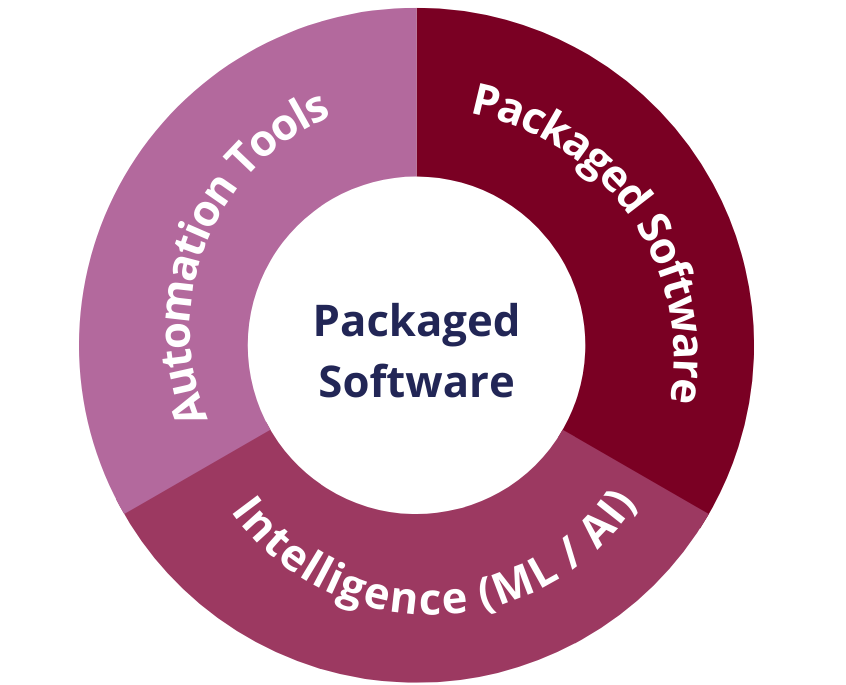
Hyperautomation is a strategic trend that combines disruptive technologies, including intelligent process automation, robotic process automation (RPA), process intelligence, artificial intelligence (AI), and machine learning (ML), to create an end-to-end automated solution for business users in real-time.

In addition to extending across a range of tools, hyperautomation also refers to the sophistication, or steps, of automation (i.e, discover, analyse, design, automate, measure, monitor, reassess.)
In that sense, hyperautomation is an expansion of automation in both breadth and depth. Gartner explains it as going from thinking of automation as ‘simply’ RPA and task automation to thinking of automation as highly sophisticated, AI-based process automation.
It drives higher-level functioning from task automation to orchestration to intelligence, enabling predictive insights, guided recommendations, process mining, and adaptive decision making.
Where automation can be the simple optimization of task processes (where you set up a bot to perform a series of tasks), hyperautomation has an extra layer of robotic ‘intelligence’ that makes the processes even smarter. You could say that where automation is the use of a robot’s arms to perform tasks quicker and with less errors, hyperautomation makes use of the robot’s brain to perform those tasks in a smarter way.
This extra layer of intelligence can include AI technologies in various forms. For example:
When combined with automation software, these technologies dramatically expand the automation possibilities.
Identification of automation use cases
Organizations often fail to identify where to start, scale, or extend automation technologies. So, to be successful we need high-end automation technology like hyperautomation.
No roadmap
Often organizations do not have a long-term strategic roadmap for their hyperautomation journey or a plan to scale automation.
Lack of governance
Organizations need a robust governance mechanism to integrate hyperautomation efforts and follow strategic technology trends.
Siloed Technology
Simply plugging your advanced technologies initiatives into the stack can lead to future scaling challenges. Technologies like AI or RPA can help accomplish automation goals in a local scope.
Erases automation restrictions
There is no doubt that each technology has its own limitations and restrictions. But with hyperautomation, businesses no longer have to face challenges due to the inefficiency of one particular technology.
Eases the integrations
Hyperautomation simplifies data sharing across multiple applications and devices with the integration of advanced technology. It also facilitates smoother and quicker data access.
Increases Business Productivity
Enhancing productivity is probably one of the most substantial benefits of hyperautomation. It can automate time-consuming and repetitive tasks so that the employees can spend time on other important value-adding activities such as forming closer relationships with customers. Thus, initiating business growth.
Using AI and ML
Capitalising on AI and ML-based learning capabilities brings intelligence to your processes. You can smoothly route tasks from inbound channels to the correct users, make smarter decisions, and provide more context to your interactions with customers.
Using Process intelligence
Optimize your hyperautomation efforts by taking advantage of tools, such as advanced analytics and process mining, to gauge the health of your business processes, select the proper automation techniques, and make informed decisions.

To solve your hyperautomation needs holistically, a platform-based approach is imperative to streamline and maximize the capabilities of these technologies. The crux lies in bridging silos – both functional and technological – and creating an integrated platform strategy.
At AMO we use key technologies that form the fulcrum of hyperautomation tools and strategies to build bespoke automation solutions to promote innovation both in the back-end and core functions of our customers using UiPath and Nintex technologies. These range from Business Process Management (BPM), Robotic Process Automation (RPA), business rules management, decision management, and low code application platforms.
Want to discuss your automation needs, get in touch with our team!
We gather information about your needs and objectives of your apps. Unsure about the app you need? We will carefully assess your top challenges and provide expert guidance on the perfect solution tailored to your success.
We create wireframes and an interactive prototype to visualise the app flow and make changes as per your feedback.
Estimation of the project deliverables including the resources, time, and costs involved.
Showcasing POC to relevant stakeholders illustrating the functionalities and potential of the app to meet business objectives.